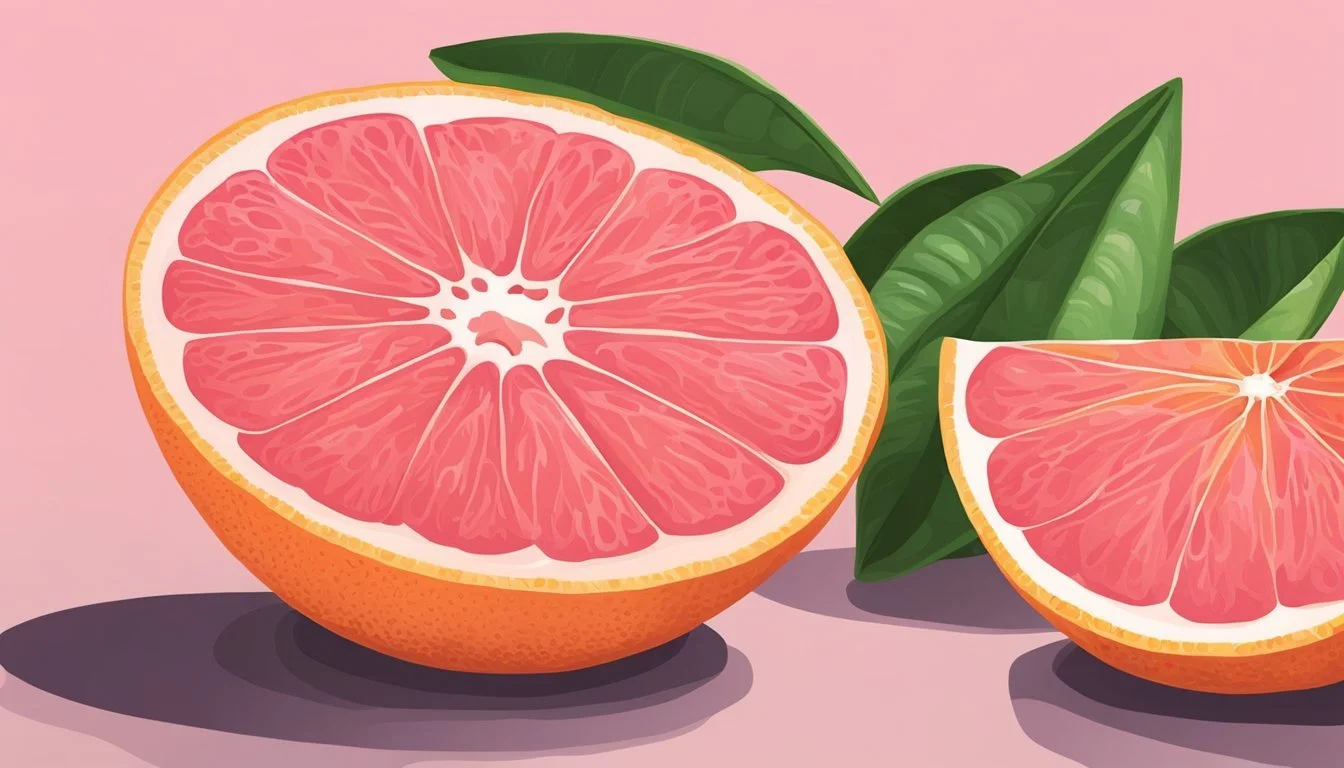How to Tell if a Pink Grapefruit is Ripe
Your Ultimate Guide to Perfect Citrus Selection
Selecting the perfect pink grapefruit can enhance your eating experience by providing a delicious, juicy fruit that's both tangy and sweet. Knowing when a pink grapefruit is ripe is essential for enjoying its optimal flavor and nutritional benefits. A ripe pink grapefruit should feel firm with a slight give when pressed gently. The skin should be a vibrant pinkish-orange without any green tinges, indicating the fruit has reached its peak sweetness. Additionally, a ripe grapefruit will emit a sweet, citrus aroma, further confirming its readiness for consumption.
It's also important to pay attention to the weight of the fruit. A ripe grapefruit will feel heavy for its size, suggesting a juicy interior. While the external color can be a good indicator, sometimes a grapefruit can be ripe even with a few green spots remaining. Therefore, combining visual cues with tactile examination ensures that you select the best fruit. After selecting a ripe pink grapefruit, proper storage can maintain its quality, keeping it at room temperature if it will be eaten soon, or refrigerating it to extend its freshness.
Key Takeaways
A ripe pink grapefruit should have a consistent vibrant pinkish-orange color and feel firm with a slight give.
The fruit's aroma is sweet and citrusy, while its weight indicates a juicy interior.
Proper storage involves keeping the grapefruit at room temperature for immediate consumption or refrigerating it for later use.
Identifying Ripe Pink Grapefruit
A ripe pink grapefruit provides certain sensory cues that facilitate its selection. These signs, when combined, are reliable indicators of ripeness.
Color and Appearance
A ripe pink grapefruit will exhibit a vibrant pink to reddish coloring. The hue should be uniform across the fruit's skin, without significant green spots that suggest under-ripening. It's important to look for a clean, smooth surface devoid of any major blemishes or signs of damage.
Touch and Texture
The skin of a ripe grapefruit should be firm but with slight pliability; when gently squeezed, the grapefruit should yield a bit under the pressure of one's fingers. In terms of texture, the skin should feel smooth overall. Any excessively soft spots or an overly rough texture can indicate over-ripeness or spoilage.
Weight and Heft
A ripe pink grapefruit feels heavy for its size, an indication that it is full of juice. One should expect a plump and dense feeling when lifting the fruit; a lightweight specimen may not provide the juicy interior that signifies a ripe fruit.
Aroma and Fragrance
The smell of a ripe pink grapefruit will be pleasantly sweet and aromatic. When held close, it should emit a noticeable fragrance that alludes to the flavor inside. A lack of aroma or an unpleasant sour smell can be a sign that the fruit is either not yet ripe or past its prime.
Selecting and Storing Pink Grapefruit
Selecting the right pink grapefruit ensures maximum flavor, while proper storage extends its shelf life. These two considerations are pivotal for enjoying the freshness of the fruit.
Choosing the Perfect Piece of Fruit
When selecting pink grapefruit, individuals should look for fruit that is firm to the touch with a slight give. The skin should be smooth and the fruit should feel heavy for its size, indicating juiciness. Uniform color without green or brown spots is also important for peak ripeness. Always avoid grapefruits that are overly soft or have a sour smell.
Proper Storage Methods
After purchase, pink grapefruits can be stored at room temperature or in the refrigerator depending on how soon one plans to consume them. At room temperature, grapefruits will remain fresh for about a week, while in the refrigerator, particularly in the crisper drawer, their shelf life can be extended to two to three weeks. To prevent the fruit from absorbing odors, it's advisable to store them away from strong-smelling foods. It’s also essential to keep grapefruits away from ethylene gas-producing fruits, as this can hasten spoilage.
Pink Grapefruit Varieties
When selecting a pink grapefruit, one must consider the different varieties available which vary in flavor and sweetness. This section will explore the differing types and their distinct taste profiles.
Understanding Different Types
Pink grapefruit, a subgroup under the general category of grapefruit, comes in an array of types resulting from various breeding efforts.
Redblush/Pink: This variety is known for its reddish-pink flesh and is one of the most common types found in grocery stores.
Thompson: Close in appearance to the Redblush, the Thompson has a slightly lighter pink interior and offers a good balance of sweetness and tartness.
Ruby Red: A darker pink variety, usually regarded as the benchmark for pink grapefruit. It was the first grapefruit to receive the "red" designation in the grapefruit category.
Star Ruby: With its deep red flesh, it is less acidic than Ruby Red and typically sweeter.
Flame: Similar to the Ruby Red but with a more intense red color and a higher sugar content, resulting in a sweeter taste.
These varieties have been cultivated not only for their vibrant colors but also for their distinct flavors, differing levels of sweetness, and availability.
Flavor Profiles
The flavor of the pink grapefruit varieties hinges on the balance of sweetness and acidity.
Ruby Red: A benchmark for sweetness among pink grapefruits, it serves as a good indicator of the desired sweetness level.
Star Ruby: Offers a notably sweet flavor profile with minimal tartness, making it a favorite for those who prefer less acidic citrus.
Redblush/Pink: Provides a classic grapefruit taste that is mildly sweet and refreshingly acidic, embodying the traditional grapefruit flavor balance.
Thompson: Maintains a more moderate sweetness alongside its acidity, not veering too far into either extreme.
Flame: Known for its sweetness emphasized over its mildly tart notes.
This spectrum of flavors from sweet to tart allows for a variety of choices to suit different taste preferences, and the inclination towards a type may differ based on one's palate. Whether one prefers a juicy burst of tartness or a sweeter, milder fruit, the pink grapefruit varieties cater to a wide range of flavor desires.
Optimal Conditions for Grapefruit Ripening
The ripening of grapefruit is an exacting process that hinges on specific climatic conditions and attentive tree care. By tuning in to these critical factors, growers can ensure that grapefruit reach their peak of ripeness.
Climatic Factors
Sunlight and heat are pivotal in the grapefruit ripening process. These fruits thrive in regions that offer ample sunlight and consistently warm temperatures, including warm nights. The ideal climate for grapefruit ripening includes:
Sun Exposure: Full sun is essential for grapefruit trees, necessitating at least 8 hours of direct sunlight daily.
Temperature: Warm days and moderately warm nights are preferable, which expedite the sugar accumulation crucial for ripeness.
Season: Typically, grapefruit ripen in late autumn, although this can vary depending on regional climate variations.
Tree Care and Harvesting
Proper tree care is paramount for the grapefruit to reach and maintain optimal ripeness. Several factors come into play:
Water: Consistent and adequate water ensures healthy growth and fruit development. Irrigation should be adjusted according to the season and the tree's lifecycle stages.
Ripeness Indicators: Trees signal when the grapefruit is ready to pick through color changes and fruit heaviness. A ripe grapefruit will feel heavy for its size and have a uniform color without green hues.
Harvest Time: Determining when to pick grapefruit involves monitoring the fruits over the season and evaluating the above indicators, as timing can differ between growing areas depending on local conditions.
Signs of Overripe or Spoiled Fruit
Identifying overripe or spoiled pink grapefruit is crucial to ensuring the freshness and quality of the fruit. Be mindful of various visual, tactile, and olfactory signs when assessing the condition of grapefruit.
Visual Indicators
The skin of overripe or spoiled grapefruit often shows distinct changes. One should look for:
Color: A grapefruit that is overripe may exhibit a dull yellow color or have brownish spots.
Wrinkling: The presence of wrinkled or shriveled skin can indicate moisture loss and age.
Mold: Any signs of mold, which could appear as fuzzy white, green, or black patches, signal that the grapefruit has gone bad.
Tactile Cues
The texture of the grapefruit provides important cues:
Firmness: A fresh grapefruit should be firm with a slight give. If it feels mushy or overly soft, it is likely overripe or spoiled.
Weight: A grapefruit that's lighter than expected for its size can indicate that it's dehydrated and past its prime.
Olfactory Signs
Smell is a telling factor when it comes to fruit ripeness. Grapefruit has a distinctive fragrance:
Odor: A spoiled grapefruit may emit a sour or fermented smell, rather than its typically fresh, citrusy aroma.
If the fruit gives off an unpleasant or decay-like odor, it is a clear sign that it has gone bad and should not be consumed.
Health Benefits and Nutritional Information
Pink grapefruit is a highly nutritious citrus fruit loved for its tangy yet somewhat sweet flavor. It offers an abundance of vitamin C and is a low-calorie option that fits well into a balanced diet.
Vitamin Content
Pink grapefruit is revered for its high vitamin C content, a crucial antioxidant, enhancing immune system function and skin health. A fresh half grapefruit, roughly 3 3/4" in diameter, provides approximately:
Vitamin C: 50-70 milligrams (mg)
Vitamin A: 28-35% of the Recommended Dietary Allowance (RDA)
Dietary Advantages of Pink Grapefruit
Pink grapefruit holds several dietary advantages, making it a compelling choice for a healthy diet:
Low Caloric Density: One cup of pink grapefruit sections with juice has just about 69 calories, promoting weight management.
Fiber: Offers around 2 grams of dietary fiber, aiding in digestion and satiety.
Hydration: Composed primarily of water, helping to hydrate the body.
Micronutrients: A source of potassium and small amounts of magnesium and calcium.
Incorporating Pink Grapefruit into Recipes
When ripe, pink grapefruit offers a robust balance of tart and sweet flavors, making it a versatile citrusy addition to various recipes. To gauge ripeness, one looks for slightly soft skin and a fruit that is heavy for its size, indicating ample juice content. To incorporate pink grapefruit into meals, chefs apply both its flesh and juice to enhance flavor profiles.
Salads: Add a tangy twist to green salads by including segments of ripe pink grapefruit. Combinations with spinach, feta, pecans, and red grapes create a refreshing dish. A drizzle of red wine vinegar completes the taste experience.
Beverages: Utilize pink grapefruit juice to craft vibrant drinks. For a Pink Grapefruit Margarita, mix the juice with lime and tequila for a citrusy refreshment. Similarly, a Pink Grapefruit Mimosa enlivens brunch with its sparkling personality; simply combine the fresh juice with sparkling wine.
Marmalades and Preserves: To capture the essence of pink grapefruit, one can prepare marmalades. It involves simmering the fruit with sugar and often lemon juice until the desirable consistency is reached. The result is a preserve that infuses bread and pastries with a burst of citrusy flavor.
When working with grapefruit, chefs often seek the fruit's natural sweetness to counterbalance its inherent tartness. Recipes are tailored to amplify the grapefruit's distinctive taste without overpowering the dish. Whether used in savory salads, refreshing cocktails, or sweet preserves, ripe pink grapefruit adds a delightful zest to any meal.
Tips to Accelerate the Ripening Process at Home
When it comes to ripening a pink grapefruit at home, patience is key but there are methods to speed up the process. These methods capitalize on the natural production of ethylene gas, a plant hormone responsible for ripening.
The Banana or Apple Technique: Simply place an unripe pink grapefruit in a bowl along with a ripe banana or apple. These fruits release ethylene gas which can expedite the ripening of the grapefruit.
Enclosed Environment: Keep the grapefruit in a paper bag at room temperature. The enclosed space will concentrate the ethylene gas around the fruit, thus speeding up the ripening. For additional effect, add a banana or apple to the bag as they will boost the ethylene levels.
A Warm Spot: Position the grapefruit in a warm area of your home, but away from direct sunlight which could cause it to spoil. A consistent warmer temperature can aid in the ripening process.
Here's a quick reference table summarizing the tips:
Tip: Banana or Apple Technique
Instructions: Place grapefruit with a ripe banana or apple. Check daily for ripeness.
Considerations:
Tip: Enclosed Environment
Instructions: Store in a paper bag at room temperature. Add other ethylene-producing fruits for effect.
Considerations:
Tip: A Warm Spot
Instructions: Put grapefruit in the warmest spot away from direct sunlight.
Considerations: Overexposure to heat may spoil the fruit.
Remember, these methods can speed up the process, but nature cannot be rushed entirely. Grapefruit's skin may not indicate its ripeness accurately, so it's essential to test the fruit by touch and feel, looking for a slight give.
FAQs: Common Questions about Pink Grapefruit
Q: How can one determine if a pink grapefruit is ripe?
A: The color of a ripe pink grapefruit should be a deep, rich pink. The skin ought to have a firm yet slightly yielding feel when gently squeezed. It should also be heavy for its size, indicating juiciness.
Q: What does the color of a ripe pink grapefruit indicate?
A: A ripe pink grapefruit will exhibit a uniform pink coloration without green tinges. The vibrant color is a good indicator of its readiness to be eaten.
Q: Can the sweetness of the grapefruit be determined without tasting it?
A: A ripe pink grapefruit often gives off a sweet, citrus fragrance. The aroma becomes stronger as the fruit reaches peak ripeness — a reliable indicator of a sweet, less acidic taste.
Q: What are the signs that a grapefruit may be overly ripe or sour?
A: Brown or overly soft spots on the grapefruit may suggest overripeness, while a sour smell indicates that the fruit may taste more sour and acidic than desired.
Q: Are there any textural cues that signal a grapefruit is ready to eat?
A: Yes, a ripe pink grapefruit should have a smooth texture with a firmness that lightly gives under pressure, suggesting the fruit inside is ripe and potentially juicy. Excessive softness or wrinkling can signal an overripe fruit.




